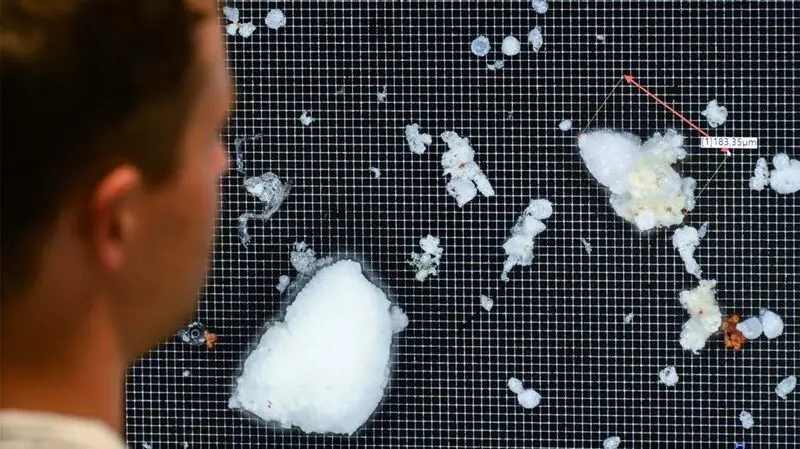
- Atherosclerosis — the buildup of plaque in the arteries — is considered to be the cause of about 50% of all deaths in Western society.
- Researchers from the University of Campania Luigi Vanvitelli in Italy have found the presence of microplastics within arterial plaques.
- Scientists reported that people with microplastics in their arterial plaque were 4.5 times more likely to have a heart attack, stroke, or die in about 34 months after their carotid endarterectomy surgery than those who did not have plastics in their plaque.
Atherosclerosis is a cardiovascular condition that occurs when the insides of the arteries of the body become clogged with a buildup of cholesterol and fats known as plaque.
Researchers estimate that about
People who have atherosclerosis are at a higher risk for
Now researchers from the University of Campania Luigi Vanvitelli in Italy have found another potential issue with arterial plaques — the presence of
In a new study published in The New England Journal of Medicine, scientists report that about 60% of study participants who had received a carotid endarterectomy had measurable amounts of
As many as 12% also had
Researchers also discovered that people with microplastics in their arterial plaque were 4.5 times more likely to have a heart attack, stroke, or die in about 34 months after their surgery than those who did not have plastics in their plaque.
Small pieces of plastic less than 5 millimeters (mm) long are considered microplastics.
“Microplastics are tiny plastic particles that are either intentionally manufactured — like microbeads and glitter — or formed from the breakdown of plastic products like clothing and food packaging in the environment,” explained Rebecca Fuoco, director of science communications at the Green Science Policy Institute, who was not involved in this study.
“We can ingest them from food and water, inhale them from the air, and absorb them through our skin,” she noted.
Past studies show humans and animals can be exposed to microplastics through contaminated
Researchers estimate that Americans
Previous research has linked microplastics in the body to an increased risk of
According to Dr. Raffaele Marfella, professor in the Department of Advanced Medical and Surgical Sciences at the University of Campania Luigi Vanvitelli and lead author of the current study, many studies have observed the presence of microplastics and
“The interest comes from our background related to the study of atherosclerosis,” Dr. Marfella told Medical News Today. “Specifically, the increase in cardiovascular events in patients with no or few risk factors led us to consider and search for other conditions that could influence the progression of atherosclerosis and, thus, cardiovascular events.”
“In this context, we think pollution, especially the enormous amount of plastic, contaminates our planet,” he continued. “So we first wondered whether plastic, in the form of micro- or nanoplastics, could also degrade our arteries and whether the presence of such a biologically inert material could alter the health of our vessels.”
For this study, Dr. Marfella and his team recruited 304 people who had undergone a carotid endarterectomy for asymptomatic carotid artery disease. Scientists examined the removed blood vessel plaque for the presence of microplastics and nanoplastics.
Researchers found measurable amounts of polyethylene in the plaques of about 60% of study participants. They also found PVC in the plaques of 12% of participants.
Dr. Marfella told us that:
“The plastic presence in human atherosclerotic plaques is surprising. Unfortunately, human tissue plastic contamination is not unique but widespread. It is worrisome their likely effect on cardiovascular Health.”
Scientists also successfully followed 257 participants for up to 34 months. They found that the study participants with microplastics found in their plaques were 4.5 times more likely to have a heart attack, stroke, or die in the 34 months following their plaque removal surgeries, compared to those who did not have plastics in their plaque.
Dr. Marfella said he and his team were somewhat surprised by this finding, although in vitro and animal studies have already demonstrated the harmful effects of plastic contamination.
“People must become aware of the risks we are taking with our lifestyle,” he continued. “We could use less plastic and direct our daily choices towards other materials. To date, it is challenging, if possible, to avoid plastic contamination.”
“Our data will elicit an awareness of the problem that will inevitably lead to more virtuous actions for our environment,” Dr. Marfella added.
“I hope that the alarm message from our study will raise the consciousness of citizens, especially governments, to finally become aware of the importance of the Health of our planet. To put it in a slogan that can unite the need for Health for humans and the planet, plastic-free is Healthy for the heart and the earth,” he suggested.
MNT also spoke with Dr. Yu-Ming Ni, a board-certified cardiologist and lipidologist at MemorialCare Heart and Vascular Institute at Orange Coast Medical Center in Fountain Valley, CA, about this study.
Dr. Ni, who was not involved in the research, commented that the findings were a “terrifying revelation.”
“We just make so much plastic in our environment and to see it degrade and get to a microscopic level and be unable to be further broken down — it’s everywhere,” he continued. “And we’re only just starting to scratch the surface as to how that’s going to affect our health certainly from a cardiovascular standpoint, but in general. I don’t know what this means, but it’s certainly quite scary to think about it.”
“One of the questions I wonder about from a cardiac standpoint is what microplastics and cholesterol plaque do to the stability of that plaque because, after all, all it takes is a disruption of cholesterol plaque to develop a heart attack,” Dr. Ni added.
“So if these microplastics make plaques more vulnerable, we could see an increase in heart attacks in patients who have microplastic exposure. So this is where the next step has to be — does it make plaque more vulnerable? What [are] the physiologic effects [on] the blood vessel walls themselves? And then most importantly, how can we address this?” he wondered.
Fuoco, who also reviewed this research for MNT, agreed it is critical to better understand the human health impacts of microplastics because they are everywhere.
“We have reason to believe they are harmful because of emerging human research like this study, as well as a large body of evidence that they can cause reproductive, developmental, and other harms in marine animals,” she explained.
“We need research, innovation, and policy action to address the root of the problem, which is the proliferation of plastics and petrochemicals. Many uses of the worst kinds of plastics are non-essential or already replaceable with safer materials. For others, we need to speed research into alternatives that aren’t made from fossil fuels or loaded with petrochemicals,” said Fuoco.





